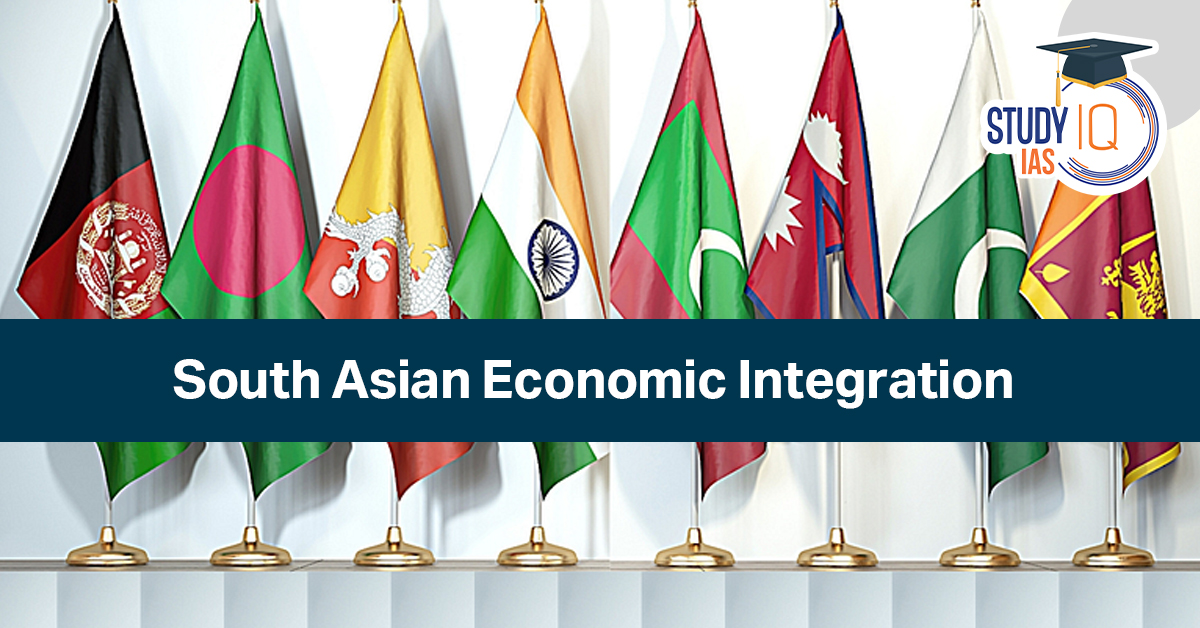Table of Contents
Context: The Recent two major incidents–the reciprocal tariffs imposed by the Trump administration and the terror attack in Pahalgam– shook India’s economic and national security landscape. These events highlight the urgent need for India to foster deeper regional integration with South Asian countries.
About South Asian Countries
- Countries: The region includes Afghanistan, Bangladesh, Bhutan, India, Maldives, Nepal, Pakistan, and Sri Lanka (collectively forming SAARC).
- Population: Accounts for about 25% of the global population.
- Combined GDP: Approximately $5 trillion, much lower than other major economic blocs.
Potential of South Asia
- Large Untapped Market: According to a United Nations Economic and Social Commission for Asia and the Pacific (UNESCAP) study, estimated that South Asia’s potential trade could reach $172 billion (2020), while actual intra-regional trade is only about $23 billion.
- Trade Growth: Despite growth in total trade value ($1,335 billion between 2015-2022), intra-regional trade forms just 5–7% of total international trade, the lowest among global blocs.
- Unexploited Capacity: Over 86% of trade potential remains untapped. Bangladesh (93%), Maldives (88%), Pakistan (86%), and others have the highest unexploited trade proportions.
Issues Hindering South Asia’s Potential
- High Trade Costs: Intraregional trade costs are 114% of goods’ value, higher than trade with distant partners like the US (109%).
- Political Tensions: Border disputes, lack of trust, and terrorism disrupt trade and regional cooperation.
- Inefficient Mechanisms: Trade agreements like SAFTA exist, but poor implementation and persistent conflicts limit their impact.
- Declining Trade Ratios: Trade-to-GDP ratio fell from 3% (2022) to 42.94% (2024).
- Widening Deficits: The Regional trade deficit increased from $204.1 billion (2015) to $339 billion (2022).
- Declining Bilateral Trade: India-Pakistan trade fell from $2.41 billion (2018) to $1.2 billion (2024).
| Regional Forums in South Asia |
|
Way Forward
- Prioritize Regional Cooperation: Depoliticise trade by keeping economic cooperation above bilateral disputes.
- Lower Trade Barriers: Simplify customs, harmonise standards, and implement SAFTA provisions effectively.
- Build Trust: Encourage dialogue, conflict resolution, and people-to-people connections to reduce mistrust.
- Enhance Connectivity: Invest in cross-border infrastructure, logistics, and digital links to reduce trade costs.
- Promote Regional Value Chains: Foster complementary industries to strengthen regional supply chains.
- Leverage Services and Investment: Tap into the potential for trade in services and cross-border investments.
- Strengthen Regional Institutions: Reform and empower SAARC and related bodies for more effective governance.


 Iran Nuclear Crisis and India’s Role f...
Iran Nuclear Crisis and India’s Role f...
 H1B Visa Program, Beneficiaries, Eligibi...
H1B Visa Program, Beneficiaries, Eligibi...
 Comparison Between India & France's ...
Comparison Between India & France's ...

























